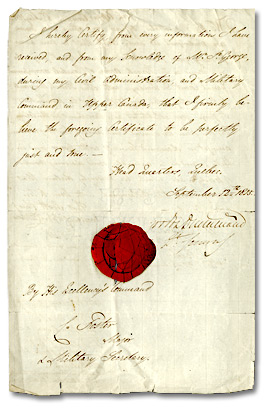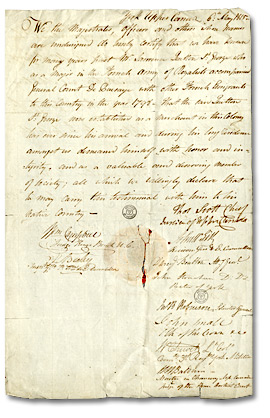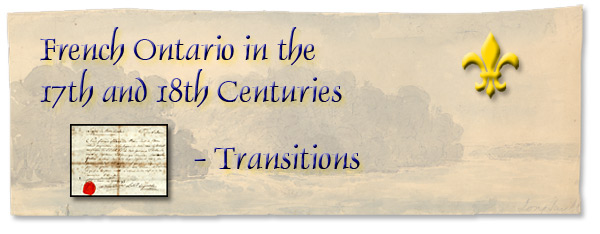
Table of Contents
Making Contact | Transitions | Resources and Trade
People, Places and Times | War and Defence | To Learn More
|
|
||
|
For the Canadiens (as the descendants of the first French settlers were then called), the Conquest meant foreign rule, new criminal (and at first) civil law, and loss of access to part of the interior. The Great Lakes area was first (1763) designated as “Indian Territory”. It was then (1774) joined to the Province of Quebec and French civil law was re-introduced. The American Revolution brought other changes. The Second Treaty of Paris (1783) acknowledged the independence of the United States and placed the new frontier along the centre of the Great Lakes. Loyalists migrated to the British colonies, resulting in the creation of Upper Canada (1791), which had an English-speaking majority and British Common Law. |
|
|
|
Through those changes, some Canadiens continued to play a role in the economic and political life of what became Upper Canada. Here are some of their stories. |
||
|
|
||
|
|
|
|
|
The Babys consolidated their economic position with alliances, both commercial and matrimonial, with Canadien and British families in Detroit and Montreal. Their descendants would continue to play a role in the political and economic life of both Upper and Lower Canada throughout the late 18th and 19th century; one of them was Jacques’ son, Jacques (James) (1763-1833). The painting below depicts the opening of the first session of Upper Canada's Legislative Assembly. James Baby is the man identified by the yellow circle. |
||
|
|
||
|
The first Lieutenant-Governor of Upper Canada, John Graves Simcoe, appointed James Baby to the first Executive and Legislative Councils in 1792. Between 1792 and 1830, he held more than 115 positions within the colonial administration, including those of militia captain, Justice of the Peace and Inspector General. Baby was also part of the Family Compact, the conservative-minded group that controlled Upper Canada’s political life during the first half of the 19th century . |
||
|
|
||
|
James’ success was not limited to politics. Despite losses when the British left Detroit in 1796 and again during the War of 1812, as well as the decline of the fur trade in the Great Lakes area, he maintained a solid financial position. At the time of his death, he owned lands in various parts of Upper Canada, mostly in the south-east and in York (Toronto). |
||
|
|
||
|
|
||
|
Jean Baptiste too served as an interpreter, and then a merchant. He soon traded with the Mississaugas and the Six-Nations (Iroquois), in an area stretching from the Bay of Quinte to the Grand River. His marriage to Margaret Clyne, the white adopted daughter of Mohawk leader Thayendanegea (Joseph Brant), benefited Rousseau in his dealings with both the First Nations and the colonial authorities. Also to facilitate his dealings with authorities, Rousseau sometimes used an anglicized version of his name, John Baptist. |
|
|
|
|
||
|
|
||
|
Rousseau settled with his family on the site of his father’s store at Toronto, in 1792. |
||
|
|
|
|
|
Two years later, Rousseau moved to Ancaster, where he built a general store and a mill. As well as owning properties in Ancaster, Rousseau owned properties on the Thames River. He continued to serve as an interpreter and became a tax collector and, as a militia officer, rose to the rank of lieutenant-colonel. Rousseau served in that capacity at the start of the War of 1812, but fell ill and died in November, 1812. |
||
|
|
||
|
|
||
|
In 1798, he joined a group of French royalists, led by the Comte de Puisaye, who had been authorized by the British government to settle in York County, Upper Canada. The choice of that site by the British served two purposes: locating the new settlers, who had military experience, near York (Toronto), and keeping them away from French-speaking populations in Lower Canada and Sandwich (Windsor). The settlement, named Windham after the British minister responsible for colonies, was a failure, as the French aristocrats who formed the core of the group of settlers could not adjust to their new life. By 1802, most had returned to Britain or turned their attention to other activities. |
|
|
|
The map below shows the site proposed for the French Royalist settlement of York County (circled). The inscription immediately below appears on the back of the map. |
||
 |
||
|
|
||
|
Quetton St. George moved to York and became a merchant. His business, specializing in imported goods, was soon one of the most important of Upper Canada, with branches in Amhertsburg, Dundas, Kingston and Niagara. He also acquired land in various parts of the colony. Although he was never integrated in York’s elite, he was well considered. |
||
|
Certificate of good character for Laurent Quetton St. George, 1815 |
||
|
Quetton St. George traveled to France when the Monarchy was restored in 1815, entrusting his financial interests in Upper Canada to his associates William and John Baldwin and Jules-Maurice Quesnel. He had intended to return to York but finally settled in France. In 1820, he sold his shares in his business to his partners. His lands in Upper Canada, which he had willed to his son Henry, were confiscated by the government in 1831 as foreign-owned property. |
||
|
Previous | Home | Next |
||
 he Ohio Valley and the Great Lakes were strategically important
areas during the
he Ohio Valley and the Great Lakes were strategically important
areas during the ![Print: Quebec from the [Bason] [ca. 1780]](pics/9136_quebec_harbour_270.jpg)

 Montreal-born merchant by the name of
Montreal-born merchant by the name of 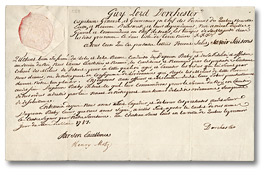
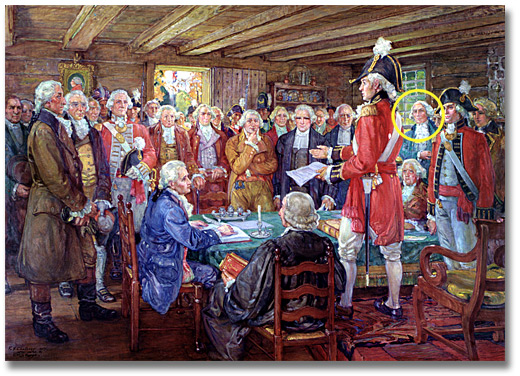
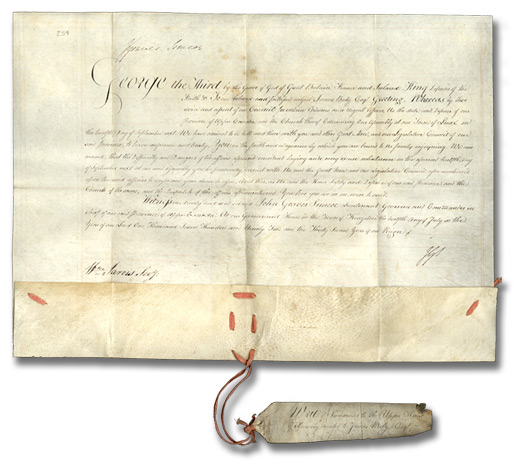

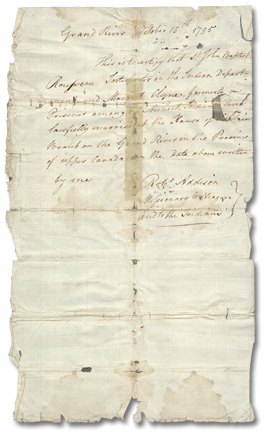
![Print: Joseph Brant (Thayendanegea), Chief of the Six Nations, [1780] (detail)](pics/13621_brant_detail_270.jpg)
![Drawing: York Harbour, [ca. 1796], Toronto, Ontario](pics/7087_simcoe_york_270.jpg)

 aurent Quetton (1771-1821) was born in southern France. Opposed
to the
aurent Quetton (1771-1821) was born in southern France. Opposed
to the 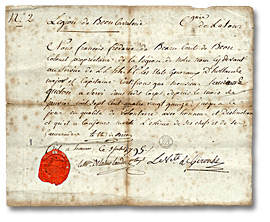
![Map: [Yonge Street L. Ontario shewing the communications from York to Lake Simcoe with a project for settling the French Royalists] [Sgd]](pics/ao1406_map_circ_520.jpg)
